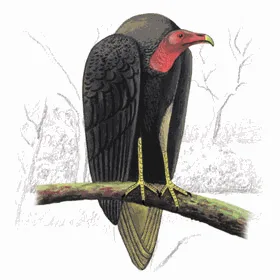
Turkey Vulture
[order] ACCIPITRIFORMES | [family] Cathartidae | [latin] Cathartes aura | [UK] Turkey Vulture | [FR] Urubu a tete rouge | [DE] Truthahngeier | [ES] Aura Gallipavo | [NL] Roodkopgier
Subspecies
| Genus | Species | subspecies | Breeding Range | Breeding Range 2 | Non Breeding Range |
| Cathartes | aura | NA, LA | widespread | ||
| Cathartes | aura | aura | w North America to Costa Rica, Greater Antilles | ||
| Cathartes | aura | jota | Pacific coast from Colombia to Tierra del Fuego, Falkland Is. | ||
| Cathartes | aura | ruficollis | Panama to n Argentina and e Brazil | ||
| Cathartes | aura | septentrionalis | e North America |
Genus
The genus Cathartes includes medium-sized to large carrion-feeding birds in the New World vulture (Cathartidae) family. The three species currently classified in this genus occur widely in the Americas.
Physical charateristics
The head of turkey vultures is perhaps the most unique characteristic, being very small in size when compared to the large body. The head and neck are red in color and lack feathers, with the exception of a thin layer of down. At an adult size, the wings cover a distance (when extended) of around 6 feet and form a shallow “V” shape when in flight. The feathers are nearly black, but the lower half of the wings on their ventral surface is silvery white. The feet are rather weak, they are used for walking rather than grasping prey. The beak is small and light in color.
Listen to the sound of Turkey Vulture
[audio:http://www.aviflevoland.nl/sounddb/T/Turkey Vulture.mp3]
Copyright remark: Most sounds derived from xeno-canto
| wingspan min.: | 140 | cm | wingspan max.: | 170 | cm |
| size min.: | 65 | cm | size max.: | 80 | cm |
| incubation min.: | 38 | days | incubation max.: | 41 | days |
| fledging min.: | 66 | days | fledging max.: | 41 | days |
| broods: | 1 | eggs min.: | 1 | ||
| eggs max.: | 3 |
Range
North America, Latin America : widespread.
Habitat
Turkey Vultures forage most often over open rangeland, casual agricultural land rather than intensive row crops, and wild areas with open forest and rocky cliffs. They can also be found scavenging shorelines for fish, seals, and other dead animals. Breeding habitat is generally in isolated rocky outcroppings or cliff sites with caves and occurs up to the subalpine forest habitat. Hollow logs, brushy areas, and abandoned buildings are also used occasionally.
Reproduction
Nesting is a secretive endeavor for Turkey Vultures which makes nest assessment difficult. Turkey Vultures do not build a nest. A usual clutch is two eggs laid 1-3 days apart; occasionally just one egg, seldom three. Incubation is approximately 35 days; fledging can be anywhere from 60-80 days. Both parents have two brood patches and incubate equally. The young are fed regurgitated food. The family bond breaks down shortly after fledging and the young don’t necessarily migrate south with their parents.
Feeding habits
Turkey vultures are scavengers, eating exclusively carrion. Most of their time is spent soaring gracefully over the land in search of the animal carcasses on which it feeds. Their keen senses of both smell (unusual among birds) and sight aid in the location of rotting meat. Because this species does not kill in order to attain food, its claws and feet alike have become rather weak appendages for grasping.
Conservation
This species has an extremely large range, and hence does not approach the thresholds for Vulnerable under the range size criterion (Extent of Occurrence <20,000 km2 combined with a declining or fluctuating range size, habitat extent/quality, or population size and a small number of locations or severe fragmentation). The population trend appears to be stable, and hence the species does not approach the thresholds for Vulnerable under the population trend criterion (>30% decline over ten years or three generations). The population size is extremely large, and hence does not approach the thresholds for Vulnerable under the population size criterion (<10,000 mature individuals with a continuing decline estimated to be >10% in ten years or three generations, or with a specified population structure). For these reasons the species is evaluated as Least Concern.

Migration
North American races migratory, moving to South USA and funnelling through Central America into N South America, and possibly S to Paraguay. South American mostly sedentary.
Distribution map

]]>
